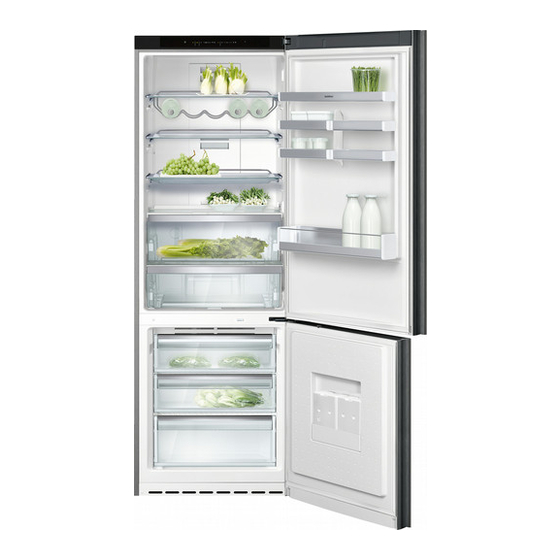Gaggenau RB 292 Petunjuk Penggunaan Manual - Halaman 12
Jelajahi secara online atau unduh pdf Petunjuk Penggunaan Manual untuk Kulkas Gaggenau RB 292. Gaggenau RB 292 19 halaman.
Juga untuk Gaggenau RB 292: Panduan Petunjuk Pengoperasian (20 halaman)

Storing frozen food
Insert frozen food container all the way to ensure
unrestricted air circulation.
If large quantities of food are to be stored in the
freezer, all the frozen food containers (except the
bottom one) can be taken out of the appliance and the
food stacked directly on the freezer shelves.
To remove a frozen food container, pull out all the way,
lift at the front and remove.
Purchasing frozen food
▯
Packaging must not be damaged.
▯
Use by the "use by" date.
▯
Temperature in the supermarket freezer must be
-18 °C or lower.
▯
If possible, transport deep-frozen food in an
insulated bag and place quickly in the freezer
compartment.
Freezing fresh food
Freeze fresh and undamaged food only.
To retain the best possible nutritional value, flavour
and colour, vegetables should be blanched before
freezing. Aubergines, peppers, zucchini and
asparagus do not require blanching.
Literature on freezing and blanching can be found
in bookshops.
Note
Keep food which is to be frozen away from food which
is already frozen.
▯
The following foods are suitable for freezing:
Cakes and pastries, fish and seafood, meat,
game, poultry, vegetables, fruit, herbs, eggs
without shells, dairy products such as cheese,
butter and quark, ready meals and leftovers such
as soups, stews, cooked meat and fish, potato
dishes, soufflés and desserts.
12
▯
The following foods are not suitable for freezing:
Types of vegetables, which are usually consumed
raw, such as lettuce or radishes, eggs in shells,
grapes, whole apples, pears and peaches, hard-
boiled eggs, yoghurt, soured milk, sour cream,
crème fraîche and mayonnaise.
Packing frozen food
To prevent food from losing its flavour or drying out,
place in airtight containers.
1.
Place food in packaging.
2.
Remove air.
3.
Seal the wrapping.
4.
Label packaging with contents
and date of freezing.
Suitable packaging:
Cling wrap, tubular film made of polyethylene,
aluminium foil, freezer containers.
These products are available from specialist outlets.
Unsuitable packaging:
Wrapping paper, greaseproof paper, cellophane, bin
liners and used shopping bags.
Items suitable for sealing packaged food:
Rubber bands, plastic clips, string, cold-resistant
adhesive tape, etc.
Bags and tubular film made of polyethylene (PE) can
be sealed with a film heat sealer.
Shelf life of frozen food
Storage duration depends on the type of food.
At a temperature of -18 °C:
▯
Fish, sausage, ready meals and cakes
and pastries:
up to 6 months
▯
Cheese, poultry and meat:
up to 8 months
▯
Vegetables and fruit:
up to 12 months
Fast freezing
Food should be frozen solid as quickly as possible
in order to retain vitamins, nutritional value,
appearance and flavour.
To prevent an undesirable temperature rise when
placing fresh food in the freezer compartment, switch
on fast freezing several hours beforehand. As a rule,
4-6 hours is adequate.
